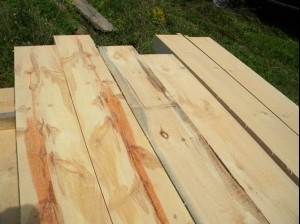I was sixteen years old in 1992, the year we started work on our log cabin. We built it out of red pine that had probably been planted in the 1940s. Dad felled the trees and my brother, Trevor, and I stripped the bark with a broad axe and a shingle scraper and a pry bar and an ice fishing spud and whatever other makeshift tools we could scrounge. I remember how the white, barkless poles shone as they lay in repose on the dark forest floor – asheen with phloem slime and sap. We stripped ten courses worth of 12” logs that summer and left them to cure where they lay. When we came back the next spring to skid them out with a length of chain and a beat up little Kubota, they hadn’t dried a lick, which in retrospect shouldn’t have been a surprise. This was the first of many mistakes we’d make.
Still, the whole experience was a joy. I remember feeling tough. Independent. Having some taste of the pioneer spirit this country was built on. Local sawyer Mike Rancourt dragged his portable Wood-Mizer up into the woods to mill the logs, and Loren Hogan, Matt Harwood, and I supplied the grunt work, piling slabs and stacking the logs into a pile by hand. The logs were green and saturated with moisture and real heavy – once we got above waist height, it was all Loren and I could do, two on a side, to lift the big ones. Matt was a thick-necked Vermont country boy – strong as a bull – and he manned the other side by himself, heaving the logs up onto the pile like Svend Karlsen in a world’s strongest man competition.
We spent the summer of ’93 building the camp, my senior year in high school. I was smitten at the time with an olive-skinned brunette who wore colorful sun dresses and New York City shades, which is to say that my brother and father spent most of the summer building the camp while I lay on the rocks at the local swimming hole composing lousy poetry. The affair ended just about the time the leaves fell, and I nursed a broken heart working side by side with dad, putting the roof on the camp. I don’t think I came out of the woods that whole first rifle season. To say that a part of me still hasn’t come out of the woods might sound overly melodramatic, but there is something life changing about that first broken heart, some lesson in the threshold-from-boy-to-manhood moment that stays with you. I never cared much for designer shades again.
Next came everything: twenty years of fishing trips with youngsters each spring; campfires under the stars each summer; the buck deer hanging from the porch in fall; ski or snowshoe treks up to camp each winter. Bachelor parties. Pig roasts. By now many in our tribe are fathers and mothers, and a new generation is scampering up the rickety ladder into the sleeping loft while the adults drink coffee and argue about town politics around the pine-slab table, mostly unaware that they’ve grown old.
The cabin needs rebuilding. Moisture was our issue – the site didn’t have enough light, and the roof overhangs weren’t long enough, and we built an uncovered deck off one side that allowed the snow to spoon with the sill logs all winter long. With moisture comes carpenter ants – we didn’t stay on top of them either. In any case, the walls are honeycombed and the sills are rotten and rather than cobbing things and limping through another 20 years, we figured we’d start from scratch and do things right this time.
Our first step this time around was to mark and fell white pine, not red. Trev, to all of our delight, married a great girl whose father happens to be a scribe-fit log cabin builder, so the poor guy gets assaulted with questions when we see him. In his opinion white is better than red, so we went that route. We marked the timber last summer and Dad, Ed Legacy, and his son Kyle cut it and skidded it down to the log yard. We had Dennis Lampron come in with a portable mill last summer, and we cut the logs down into 6 x 12 timbers – we’re going Appalachian style this time. We replaced Matt with a skid steer. And yes, we atoned and this time stickered and stacked the logs before the snow fell.
This is not to say that everything is going smoothly, though, as a lot of the wood has red rot in it. What’s red rot? Well, you can see it here in this picture. The blue stain is blue stain fungus – you can read all about it in a column Ginny wrote here. The red stuff is red rot, and it’s no good. The blue is benign, the red is cancer, essentially, that gets into a branch wound and rots the tree from the inside out. You can learn more about this in the autumn issue, as my first instinct was to send a picture to Mike Snyder and asked him to tell me all about it in a Woods Whys column. (You can send Mike questions too, you know.)
As we assemble the cabin, I’ll tell you how we do it and why, what we deemed a success, and more importantly, all the stuff we mess up. Chime in with advice if you have it, or stories from your own cabin building experiences. We’ll spend the next few blogs creating an unofficial how-to (or how not to) build a cabin document.



Discussion *